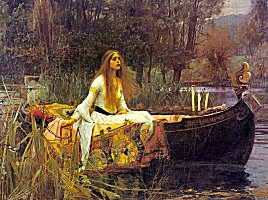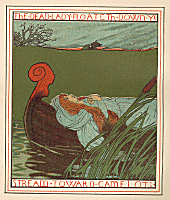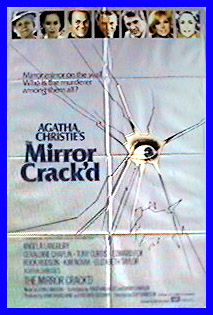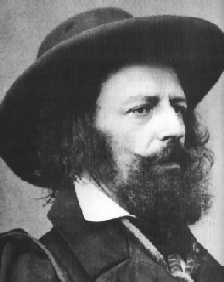scalpel_blade@yahoo.com
No texting or chat messages, please. Ordinary e-mails are welcome.
Ed Friedlander MD
scalpel_blade@yahoo.com![]()
No texting or chat messages, please. Ordinary e-mails are welcome.
If you are approaching Tennyson's poem, "The Lady of Shalott", this page will help you get started. It is intended especially for students (high-school age and older) who have read the poem in class.
 The Lady of Shalott is a magical being who lives alone on
an island upstream from King Arthur's Camelot. Her
business is to look at the world outside her castle window in a mirror,
and to weave what she sees into a tapestry.
She is forbidden by the magic to look at the outside world directly.
The farmers who live near her island hear her singing and know
who she is, but never see her.
The Lady of Shalott is a magical being who lives alone on
an island upstream from King Arthur's Camelot. Her
business is to look at the world outside her castle window in a mirror,
and to weave what she sees into a tapestry.
She is forbidden by the magic to look at the outside world directly.
The farmers who live near her island hear her singing and know
who she is, but never see her.
The Lady sees ordinary people, loving couples, and knights in pairs reflected in her mirror. One day, she sees the reflection of Sir Lancelot riding alone. Although she knows that it is forbidden, she looks out the window at him. The mirror shatters, the tapestry flies off on the wind, and the Lady feels the power of her curse.
An autumn storm suddenly arises. The lady leaves her castle, finds a boat, writes her name on it, gets into the boat, sets it adrift, and sings her death song as she drifts down the river to Camelot. The locals find the boat and the body, realize who she is, and are saddened. Lancelot prays that God will have mercy on her soul.
This is one of Tennyson's most popular poems. The Pre-Raphaelites liked to illustrate it. Waterhouse made three separate paintings of "The Lady of Shalott". Agatha Christie wrote a Miss Marple mystery entitled "The Mirror Crack'd From Side to Side", which was made into a movie starring Angela Lansbury. Tirra Lirra by the River, by Australian novelist Jessica Anderson, is the story of a modern woman's decision to break out of confinement.
|
The Lady Of Shalott 1842 Version | 1832 Version |
I
|
On either side the river lie Long fields of barley and of rye, That clothe the wold and meet the sky; And through the field the road runs by To many-tower'd Camelot; And up and down the people go, Gazing where the lilies blow Round an island there below, The island of Shalott.
| ... ... ... ... ... The yellowleavèd waterlily, The greensheathèd daffodilly, Trembled in the water chilly, Round about Shalott
|
|
Willows whiten, aspens quiver, Little breezes dusk and shiver Through the wave that runs for ever By the island in the river Flowing down to Camelot. Four grey walls, and four grey towers, Overlook a space of flowers, And the silent isle embowers The Lady of Shalott.
| ... ... The sunbeam-showers break and quiver In the stream that runneth ever ... ... ... ... ... |
|
By the margin, willow-veil'd, Slide the heavy barges trail'd By slow horses; and unhailed The shallop flitteth, silken-sail'd Skimming down to Camelot Yet who hath seen her wave her hand? Or at the casement seen her stand? Or is she know in all the land, The Lady of Shalott?
|
Underneath the bearded barley, The reaper, reaping late and early Hears her ever chanting cheerly, Like an angel, singing clearly, O'er the stream of Camelot. Piling the sheaves in furrows airy, Beneath the moon, the reaper weary Listening, whispers, "'Tis the fairy Lady of Shalott." |
|
Only reapers, reaping early, In among the beared barley Hear a song that echoes cheerly From the river winding clearly, Down to towered Camelot: And by the moon the reaper weary, Piling sheaves in uplands airy, Listening, whispers, " 'Tis the fairy Lady of Shalott."
|
The little isle is all inrailed With a rose-fence, and overtrailed With roses: by the marge unhailed The shallop flitteth silen-sailed Skimming down to Camelot: A pearlgarland winds her head; She leaneth on a velvet bed, Fully royally apparelèd, The Lady of Shalott. |
II
|
There she weaves by night and day A magic web with colours gay. She has heard a whisper say, A curse is on her if she stay To look down to Camelot. She knows not what the curse may be, And so she weaveth steadily, And little other care hath she, The Lady of Shalott.
|
No time hath she to sport and play: A charmèd web she weaves alway. A curse is on her, if she stay Her weaving, either night or day, To look down to Camelot. She knows not what the curse may be, Therefore she weaveth steadily, Therefore no other care hath she, The Lady of Shalott. |
III
|
The gemmy bridle glitter'd free, Like to some branch of stars we see Hung in the golden Galaxy. The bridle bells rang merrily As he rode down to Camelot: And from his blazon'd baldric slung A mighty silver bugle hung, And as he rode his armor rung Beside remote Shalott.
|
... ... ... ... As he rode down from Camelot: ... ... ... ... |
|
All in the blue unclouded weather Thick-jewell'd shone the saddle-leather, The helmet and the helmet-feather Burn'd like one burning flame together, As he rode down to Camelot. As often thro' the purple night, Below the starry clusters bright, Some bearded meteor, trailing light, Moves over still Shalott.
|
... ... ... ... As he rode down from Camelot: ... ... ... Moves over green Shalott.
|
|
His broad clear brow in sunlight glow'd; On burnish'd hooves his war-horse trode; From underneath his helmet flow'd His coal-black curls as on he rode, As he rode down to Camelot. From the bank and from the river He flashed into the crystal mirror, "Tirra lirra," by the river Sang Sir Lancelot.
|
... ... ... ... As he rode down from Camelot: ... ... "Tirra lirra, tirra lirra" ... |
IV
|
A cloudwhite crown of pearl she dight All raimented in snowy white That loosely flew, (her zone in sight, Clasped with one blinding diamond bright,) Her wide eyes fixed on Camelot Thought the squally eastwind keenly Blew, with folded arms serenely By the water stood the queenly Lady of Shalott. |
|
And down the river's dim expanse Like some bold seer in a trance, Seeing all his own mischance -- With a glassy countenance Did she look to Camelot. And at the closing of the day She loosed the chain, and down she lay; The broad stream bore her far away, The Lady of Shalott.
|
And down the river's dim expanse With a steady, stony glance Beholding all her own mischance Mute, with a glassy countenance She looked down to Camelot It was the closing of the day, ... ... ... |
|
Lying, robed in snowy white That loosely flew to left and right -- The leaves upon her falling light -- Thro' the noises of the night, She floated down to Camelot: And as the boat-head wound along The willowy hills and fields among, They heard her singing her last song, The Lady of Shalott.
|
As when to sailors while they roam, By creeks and outfalls far from home, Rising and dropping with the foam, From dying swans wild warblings come, Blown shoreward; so to Camelot Still as the boat--head wound along The willowy hills and fields among, They heard her chanting her deathsong The Lady of Shalott. |
|
Heard a carol, mournful, holy, Chanted loudly, chanted lowly, Till her blood was frozen slowly, And her eyes were darkened wholly, Turn'd to tower'd Camelot. For ere she reach'd upon the tide The first house by the water-side, Singing in her song she died, The Lady of Shalott.
|
A longdrawn carol, mournful, holy, She chanted loudly, chanted lowly, Till her eyes were darkened wholly, And her smooth face sharpened slowly. ... ... ... ... ... |
|
Under tower and balcony, By garden-wall and gallery, A gleaming shape she floated by, Dead-pale between the houses high, Silent into Camelot. Out upon the wharfs they came, Knight and burgher, lord and dame, And around the prow they read her name, The Lady of Shalott.
|
... ... A pale, pale corpse she floated by, Deadcold between the houses high, Dead into towered Camelot Knight and burgher, lord and dame, To the plankèd wharfage came: Below the stern they read her name, ... |
|
Who is this? And what is here? And in the lighted palace near Died the sound of royal cheer; And they crossed themselves for fear, All the Knights at Camelot; But Lancelot mused a little space He said, "She has a lovely face; God in his mercy lend her grace, The Lady of Shalott."
|
They crossed themselves, their stars they blest, Knight, minstrel, abbot, squire and guest, There lay a parchment on her breast, That puzzled more than all the rest, The wellfed wits at Camelot. "The web was woven curiously, The charm is broken utterly, Draw near and fear not -- this is I, The Lady of Shalott." |
 The story of the Lady of Shalott is a
version of "Elaine the fair maid of
Astolat", from Thomas Malory's Morte d'Arthur.
Elaine's naive
love for Lancelot was unrequited.
She died of a broken heart
(i.e., committed suicide -- Malory's book contains her justification
of suicide). Her dead body (with suicide note between her hands)
was floated down the Thames to Camelot. Eventually Tennyson
wrote a long poem about "Lancelot and Elaine".
It contains the line which I have
found helpful, "He makes no friend who
never made a foe."
The story of the Lady of Shalott is a
version of "Elaine the fair maid of
Astolat", from Thomas Malory's Morte d'Arthur.
Elaine's naive
love for Lancelot was unrequited.
She died of a broken heart
(i.e., committed suicide -- Malory's book contains her justification
of suicide). Her dead body (with suicide note between her hands)
was floated down the Thames to Camelot. Eventually Tennyson
wrote a long poem about "Lancelot and Elaine".
It contains the line which I have
found helpful, "He makes no friend who
never made a foe."
However, Tennyson claimed he did not know the English version of the story in 1832, when he wrote the first draft of the poem. He took it from an early renaissance Italian story "Quì conta come la Damigella di Scalot morì per amore di Lancialotto de Lac." The body ends up on the Camelot beach, with a letter, and is examined by a crowd.
I met the story first in some italian novelle: but the web, mirror, island, etc., were my own. Indeed, I doubt whether I should ever have put it in that shape if I had been then aware of the Maid of Astolat in "Morte Arthur".
Like many other famous poems, this one deals (on one level) about writing poetry. Tennyson's son Hallam quoted his father as saying it's about:
the new-born love for something, for some one in the wide world for which she had been so long excluded, takes her out of the region of shadows into that of realities.
Hallam also said:
The key to this tale of magic symbolism is of deep human significance and is to be found in the lines
Or when the Moon was overhead,
Came two young lovers lately wed;
"I am half sick of shadows," said
The Lady of Shalott.
Tennyson likes to write poems about creatures lost in half-life, and/or people taking decisive, heroic action that leads to their doom.

Here are some more interesting things to notice about "The Lady of Shalott":
 What's It All About, Alfie?
What's It All About, Alfie?
It's the Lady's romantic yearnings that finally make her look out the window. In the 1830's, a poet was supposed to be a spokesman for a "Victorian" ideal in which sexuality is suppressed. Tennyson wrote "The Lady of Shalott" in his early 20's, just after being forced to leave Cambridge for financial reasons. He would not marry until 1849. The young Tennyson must have wondered whether he could hold to the supposed contemporary standard for a single man rather than seeking out sexual relationships. He must have been afraid that choosing the latter would ruin his morals and his writing.
You can look at Tennyson's own life and letters and decide for yourself to what extent "The Lady of Shalott" reflects the hopes and fears of a young man who grew up bookish, super-smart, isolated, and probably repressed.
You can also look at what others have said about the old question of whether an artist or writer must be isolated from the ordinary world. Shakespeare and Chaucer were men of the world, who probably did not consider their writing to be their main professions. Lord Byron and Robert Burns embraced life and sexuality wholeheartedly. By contrast, Keats dropped out of medical school to become a full-time poet, Coleridge was a passive man who became dependent on the good will of others to be able to continue his work, and Emily Dickinson was a recluse. Bertoldt Brecht pretended to be a man of the working class, but he really had nothing to do with the people for whom he claimed to speak. You can supply many more examples.
Today, "The Lady of Shalott" invites us to think about:
Baldric: Belt worn over one shoulder and the opposite waist
Mischance: Bad luck (i.e., Tennyson's psychic foresees his own disaster)
Greaves: Armor for the fronts of the shins
Wold: Unforested plains, especially between forests.
Partisans of the Religious Right can point out the dangers of the occult, how the Lady was disobedient to some higher authority by seeking out sexual experience, how a good person stays aloof from the world, etc., etc.
Partisans of the politically-correct Left can talk about how chivalry supposedly idealized women in order to confine and oppress them.
Partisans of scientific naturalism can discuss Tennyson as the great poet of Darwin's era, giving brilliant expression in his later works all the religious doubts of the by-then post-Christian world. Even in this early poem, the Lady gives up a world of unreality to look at and finally experience the world as it really is.
Not everybody will agree with all these positions.
I hope you like The Lady of Shalott, and that I've been of some help.
To include this page in a bibliography, you may use this format: Friedlander ER (1999) Enjoying "The Lady of Shalott" by Alfred Tennyson Retrieved Dec. 25, 2003 from http://www.pathguy.com/shalott.htm
For Modern Language Association sticklers, the name of the site itself is "The Pathology Guy" and the Sponsoring Institution or Organization is Ed Friedlander MD.
More by Ed
 | Malory's Elaine argues that suicide is justifiable. But if you are reading this, suicide is almost certainly a bad idea. Among young people who made serious attempts and failed, 99% said a year later that they are glad they failed. |
 Meet Ed
Meet Ed
E-mail me
Brown University,
Department of English -- my home base, 1969-1973.
| New visitors to www.pathguy.com reset Jan. 30, 2005: |

